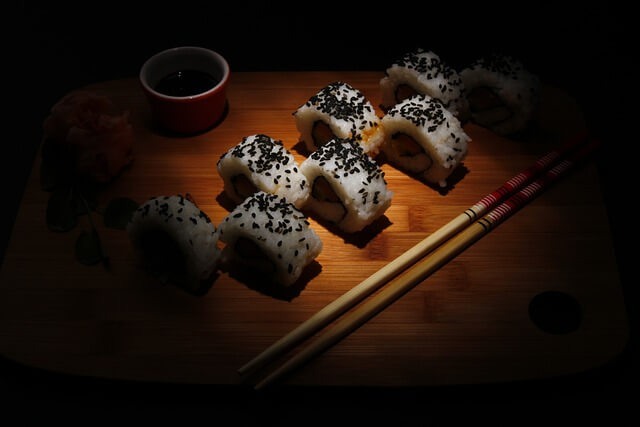You could be one of those people who tried sushi and liked everything but the seaweed? Or maybe you have everything you need to make sushi—except the seaweed. What to do? Is it possible to make sushi without seaweed?
Making sushi without seaweed is possible because the essential ingredient of sushi is not seafood but rice flavored with rice vinegar. You can use rice or soy wrappers, vegetables or fish, or turn the roll inside out. Sushi can also be pressed or shaped into balls.
Don’t worry if you are surprised by this. Most people associate sushi with the pretty sliced rolls, but sushi is not about the seaweed, raw fish, or other ingredients people associate with the dish. Rice is the key ingredient. Keep reading as we explain why you don’t need seaweed and give you delicious options.
Do You Need Seaweed for Sushi?
People are sometimes surprised to learn that sushi does not refer to the nori (seaweed) wrapper. Instead, sushi is often translated into “sour tasting,” which refers to the vinegared rice. The word sushi is a shortened form of su-me-shi. The me was dropped, leaving su, which means vinegar, and shi, which means rice.
Vinegared rice is the essential ingredient to sushi, not the nori roll, and not even the raw fish that many people associate with it.
And since we are talking about misconceptions, another one is that sushi does not even have to be rolled. Sushi can be scattered (chirashizushi), pressed (oshizushi), hand-rolled (temakizushi), and shaped into balls (temarizushi).
And one final misconception—rice vinegar for sushi has three ingredients—vinegar, sugar, and salt. There are many variations for rice vinegar recipes, but you can adjust them to your liking. The sugar to salt ratio is typically 4 to 1, but the amount of rice vinegar depends on how vinegary you want the rice.
If you would prefer to buy sushi vinegar, read the label—many contain additional ingredients, including corn syrup and MSG.
What Are Some Substitutes for Nori?
The choices for seaweed substitutes fall into three categories—other kinds of wrappers, using vegetables or fish, and turning the sushi inside out. Finally, you will get some suggestions for non-traditional sushi.
Other wrappers
If you want to make traditional sushi but want to avoid a nori wrapper’s flavor, you have several options.
Rice Paper
These thin wrappers are common in Vietnamese restaurants. Traditionally made with rice, water, and salt, many now have added tapioca starch, which is okay. Avoid those made with 100% tapioca since they will be difficult to roll without tearing.
Rice paper wrappers need to be rehydrated before you can use them to make sushi. Get a baking dish, add warm water, and put one sheet into the pan.
After a few seconds, take it out and place it on your work surface. If the paper rips, you left it in too long. Let the sheet sit until it becomes sticky—usually a minute or two. Then place it on the sushi mat and prepare your sushi as you usually would.
Soy Wrappers
These wrappers are similar to rice wrappers, except they are made with soy flour and protein. Soy wrappers have no flavor, so they will bring out the flavors of the ingredients you use for your sushi.
To use soy paper, you will have to hydrate it, although you might need to keep it in the water for longer. Otherwise, prepare the wrappers just as you would traditional sushi.
Inari
Inari is made from rectangular deep-fried tofu, sometimes called aburaage. The tofu is cut in half, and each half can be opened to create a pouch that will hold your sushi ingredients.
After you cut the tofu in half and open the pockets, drop them in boiling water for one to two minutes. When you take the inari out of the water, place it in a colander to help you get excess water out of them.
Next, make a broth using dashi or similar Japanese soup broth (this umami dashi does not contain kelp) plus equal amounts of soy sauce, sugar, and Mirin. Then put the aburaage in the broth, bring it to a boil, and then let it cook on low for about 20 minutes. The aburaage needs to cool for several hours before you can use them.
Meanwhile, prepare your sushi rice. If you plan to add other ingredients, they should be tiny. To assemble the Inari, you will press a ball of sushi rice into the pocket, and you do not want the aburaage to tear.
Wrap the Sushi in Vegetables or Fish
Instead of using vegetables or fish as a filling, why not use them in place of the nori? If you want to use vegetables, select ones with pliable flesh that will be long enough to make sushi rolls.
Cucumber is a vegetable often used in this way. Peel the skin first. Then use a long sharp knife to “unfurl” the cucumber. When you finish, you should have a cucumber “mat” onto which you can place your sushi rice and other ingredients.
You might want to scrape off the cucumber seeds before adding the rice.
Another possibility is to use fish or meat to create a “sheet” on which you will place the sushi rice and other fillings. This technique requires advanced skills with a knife.
Since you know that sushi is about the rice, not the nori, a California roll without the seaweed sheet is another option.
Non-traditional Sushi
Although we associate sushi with sliced rolls, sushi can take many forms. You’ll enjoy experimenting with these, and when family or guests say it’s not sushi, you can teach them the real meaning of sushi.
Chirashizushi
Think of chirashizushi as the taco salad of sushi. Instead of shaped or rolled, chirashizushi has a bed of sushi rice with other ingredients scattered on top (chirashi means to scatter). A traditional chirashizushi is served on a large plate and is intended to be shared on special occasions.
An advantage of this dish is the ease of making it. Whether you make a large bowl or opt for single-serving portions, after the rice is cooked, all you need to do is put it in the serving containers, add the toppings, and enjoy. That’s a lot easier than spreading out rice evenly so that your roll will not only look good but retain its shape.
Oshizushi
Traditionally oshizushi is made in an oshibako, a unique mold in which the sushi ingredients are pressed. The wooden oshibako is a rectangular mold the size of a butter dish. Slits on the sides of the oshibako let you cut the oshizushi into smaller pieces. Although the oshibako is relatively inexpensive, if you do not have one, long narrow containers will work.
A great thing about this sushi is that making it is easier than traditional sushi, but the results can be as pretty. Unlike with chirashizushi, you will not have to convince people the dish is sushi.
You’ll want to have some plastic wrap to line the inside of the container.
Then press a layer of your toppings into the bottom and put the sushi rice on top. Make sure that you press the rice down firmly. If you are using an oshibako, you will be able to slice the oshizushi before you flip it over. If not, you will need to do so after you have flipped the container and removed it.
Nigirizushi and Temarizushi
Both are hand-pressed sushi. Nigirizushi is shaped into an oval-shaped ball and temarizushi. Besides shape, both have toppings, typically thinly-sliced fish placed on top or wrapped around the sushi rice.
Nigirizushi is more common because temarizushi is traditionally prepared on Hinamatsuri, or Girl’s Day, which is March 3rd.
Bottom Line
Once you know that the key to sushi is not seaweed but the rice, you have a whole world of possibilities—other wrappers or non-traditional versions of shusi all qualify—as long as they have the vinegared (su) rice (shi).



